Art and Wellbeing
There is a burgeoning interest in the intersection between the creative arts and health and wellbeing, as countries all over the world grapple with an ageing population, the growing incidence of mental health problems across all age groups, and the need to take a more holistic attitude to the way we think about health and healing and the mind-body connection.
The 2020 COVID-19 pandemic has brought into sharp relief the links between health, economy and social collaboration in a safe society.
As the 2017 White Paper by the US National Organisation for the Arts in Health, points out: It is well known that engaging in creative experiences is vital to human health and well-being, to bridging the life experiences that divide people and society and to helping people understand the human condition.
More and more, people and institutions are turning to the arts as a bridge to transcend boundaries, illuminate ideas, to discover, and explore more effective ways to live with, inspire, heal and care for each other. These include diverse approaches, such as the use of design to create welcoming and uplifting environments; the use of the arts and humanities for the training and well-being of health professionals; the use of performing, visual and literary arts in patient, caregiver and community populations; and the expansion of the arts to enhance wellness, the process of ageing, and individual and community response to crisis and trauma.
Australian Government Arts and Health National Framework
In 2013 the Health and Cultural portfolios got together to develop a national framework on the role of the arts in health. It states that in its broadest sense, arts and health refers to the practice of applying arts initiatives to health problems and health promoting settings. It involves all art forms and may be focused at any point in the health care continuum. It also has an impact on the determinants of ill-health by changing individuals’ attitudes to health risks and supporting community resilience. The framework recognises that arts and health initiatives can be delivered across a range of settings. Benefits can accrue for all stakeholders including government, health service providers, artists, those in health care and the wider community and include improved communication, better understanding, attitudinal change and clinical outcomes. Arts and health activities have their effect through different means and are achieved through experiencing the arts as an artist or creator, as a participant or member of an audience. The framework is based on clear empirical evidence that arts and health activity is a health-promoting endeavour for all members of society.
The Health Ministers and the Cultural Ministers Framework recognises:
- That arts and health policies, programs and initiatives with deliberate health and wellbeing goals are in evidence across all states and territories and take place in a multitude of settings, including in health care facilities and within remote, rural, regional and urban communities
- This practice involves the work of different spheres of government, the not for profit sector including funded organisations and cultural heritage institutions, the community, the education sector, and others such as justice departments
- That arts and health activities have intrinsic, instrumental and institutional values and have a demonstrated range of social, artistic, environmental, cultural, economic and health benefits, including the potential to improve the quality of health care
- The contribution of arts practice to the enhancement of health and wellbeing across the continuum of health services – from encouraging healthy living and communicating on health issues, to prevention, treatment and the management of illness and chronic disease, and in rehabilitation and recovery as well as end of life care
- That attention to the arts and good design can make the difference between health environments and buildings that work and those that excel in promoting health and wellbeing for patients, staff, clients and visitors.
- That arts and health practice can contribute to achieving government objectives, in particular across the themes of better health services, reducing health inequalities and Closing the Gap on Indigenous Disadvantage
- That advancing arts and health practice in Australia relies on a diversity of sectors and stakeholders working together.
Australia’s Health Ministers and Cultural Ministers encourage collaborative partnerships across the health and arts sectors to develop strategies and new approaches to arts and health practice. Through these partnerships, and the initiatives they foster, the potential of the arts to add value to health facilities, services and care will be realised.
Australian Centre for Arts and Health
The Australian Centre for Arts and Health (ACAH) is a not-for-profit health promotion charity with DGR status, building on the achievements of national advocacy and networking organization Arts and Health Australia (AHA). ACAH hold regular annual conferences for arts and health practitioners and the health sector.
Its Patron is Hon Dame Marie Bashir AD CVO, the former Governor of NSW. Margret Meagher is the founding executive director of Arts and Health Australia, the national networking and advocacy organization, dedicated to the promotion of best practice arts and health policy, programs, medical education and research.
Margret is also a founding board member of The Australian Centre for Arts and Health Limited (ACAH) a not-for-profit organization, established as the peak body for the arts and health sector nationally and representing Australia within the international arts and health field. Margret has recently been appointed to NSW Health Infrastructure’s Arts Advisory Panel which aims to bring to life NSW Health’s Arts in Health commitment through the expanded use of various artforms in the design of public health facilities and in nurturing community and staff engagement. Other Board members are Malcolm Moir, with a background in arts sponsorship, Denis Mamo, with a background in health related marketing and advertising.The US National Organisation for the Arts in Health (NOAH)
Founded in 2016 with HQ in San Diego, California, NOAH provides transformational leadership to bring the field of arts in health together, and to move the field forward.
Our focus is on the future of arts, health, and wellbeing; and creating tangible impact from our goals and initiatives. We know through research and experience that the arts are an integral component to health, and we are committed to shaping a reality where that fact is accepted fully, and incorporated into medical treatment, medical education, prevention, and public health and wellbeing.
Noah publishes regular White Papers:
2019, Creating Healthy Communities Through Cross-Sector Collaboration
2017, Arts, Health and Wellbeing in America
2020, Creative Response to COVID-19
The NOAH team is hard at work developing resources to aid and unite the field in this difficult time.
We are currently accepting short video and visual submissions of artmaking, music, and other creative activities linked to health and wellbeing as well as stories of how our members and their programs are adjusting to meet the needs of the communities they serve. These videos and stories will be shared in newsletters, on social media, and on the NOAH website.
The following blog post is based on edited extracts from the 2017 White Paper.Contribution of the Arts to Health and Wellbeing
Throughout the United States, the arts – music, dance, theatre, literature, visual art, architecture, interior design and more – are being used to enhance healthcare, promote public health, and support community wellbeing. Those engaged in this arena include both creative and expressive arts therapists, professional artists, architects, interior designers, arts administrators, health- care arts consultants, as well as medical professionals using the arts as a complementary tool to facilitate patient well-being.
A growing array of arts practices is contributing to the enhancement of health and wellbeing across the full range of health services. This arena involves professionals using one or more art forms – music, drama, crafts, creative writing, architecture, design, film and video, painting, drawing, sculpture, and more – and may be implemented at any point in the care continuum, which consists of health services spanning all levels and intensity of care. The arts, humanities, design, and the creative arts therapies support prevention, treatment, and the management of illness and chronic disease by improving the healthcare experience and aiding in rehabilitation, recovery, human performance, and end-of-life care.
As the American healthcare system shifts its focus to caring for the whole person – body, mind, and spirit – to prevent illness, to sustain high quality of life throughout treatment, and to better manage ongoing care, the arts play a vital role in contributing to an integrated approach to human health and wellbeing.The following 6 areas of arts-based professionals are involved:
- Architects – A robust network of specialized healthcare architects exists, and many firms throughout the nation focus their practice on designing the exterior and interior architecture of healthcare facilities such as hospitals, hospices, and long- term care residences.
- Landscape architects – landscape architects perform a unique role in designing therapeutic gardens or healing gardens that are prominently featured by many institutions.
- Art consultants/advisors – Working closely with interior designers, specialized healthcare art consultants (also referred to as art advisors) are frequently secured to ensure the success of building and renovation projects.
- Healthcare Arts Administrators – It is the healthcare arts administrator who typically designs and manages the art program, including policies, procedures, standards, and structure. This can involve overseeing the ongoing maintenance of the facility’s art collection, rotating exhibits, and coordinating performing artists such as pianists, harpists, and guitarists to enhance the overall healing environment.
- Interior Designers – interior designers are responsible for creating the quality of the space to provide the optimal patient experience.
- Professional artists – Professional artists such as painters, sculptors, media artists, and musicians are frequently commissioned for a specific work associated with the building project, or are hired on an ongoing basis to enhance the healthcare environment.
Arts in Healthcare Programs
In the late twentieth century, most Arts in Health programs were designed as collaborations between professional caregivers, arts administrators, arts consultants, and artists to bring works of original art into the hospital to enhance and humanize the healthcare environment.
The first generation of arts in health programs included permanent art installations, visual art collections and rotating exhibits, performances in public and patient care areas, arts workshops for medical staff, and bedside arts activities for patients and their family members by professional artists.
The overarching goals of artists practicing arts in health and clinicians in the creative arts therapies are fourfold: to enhance the healthcare experience, to promote public health, to support community well-being, and to foster resiliency of professional and family caregivers.Healthcare Environments
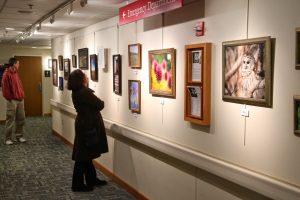 In a healthcare setting, an “environment of healing” can include architecture and design for the interior and exterior of facilities, healing gardens, permanent art integrated into architecture, and art displays. Permanent displays of art, rotating exhibits, and music performances in lobbies and other public spaces are common initiatives designed to enhance the healthcare experience.
In a healthcare setting, an “environment of healing” can include architecture and design for the interior and exterior of facilities, healing gardens, permanent art integrated into architecture, and art displays. Permanent displays of art, rotating exhibits, and music performances in lobbies and other public spaces are common initiatives designed to enhance the healthcare experience.
Architecture, the arts, and interior design can all be effective- ly used to enhance the physical environment of healthcare facilities. Specialists exist among professional architects, designers, arts consultants, and artists who are highly experienced in creating a healing environment/experience for patients and a supportive environment for staff.
Many hospitals also feature rotating exhibits of art, as well as music performances in lobbies and other public spaces. Increasingly, designers and artists use interactive digital displays as a means of enlivening spaces, engaging patients, and providing educational experiences. They also use the arts to reflect and strengthen a medical center’s brand and ties with its host community, strengthen wayfinding, and enhance philanthropy.
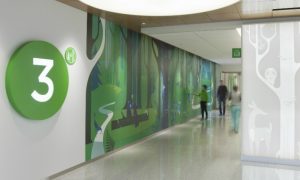 When art is thoughtfully integrated into the fabric of the building, floors, walls, and lighting through a collaboration between artists and professional designers, we return to the renaissance of art.
When art is thoughtfully integrated into the fabric of the building, floors, walls, and lighting through a collaboration between artists and professional designers, we return to the renaissance of art.
The healthcare environment extends beyond the facility’s walls to include outdoor spaces that bring the healing effects of nature to patients, staff, and visitors. It is well established in published research that connecting with natural settings improves health and enhances the human sense of wellbeing.
The inclusion of visual art into the healing garden can amplify the effects of the garden in providing a positive distraction for patients, staff, and visitors. In addition, the healing garden can offer an ideal setting for other visual arts activities (painting, drawing, writing, crafts) as well as music, dance/movement, and drama that may take place at the healthcare facility.
Today there is an increasing trend to integrate visual art into architecture through collaborations with architects, interior designers, graphic designers, and artists, where art is integrated into the floors, walls, and ceilings.
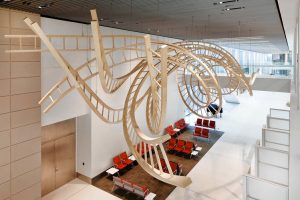 Art can do more than relax people. It can provide inspiration and memories; it can provide opportunities for meditation; it can offer messages and foster empathy; and it can be highly interactive. As a result, art directors are thoughtfully placing contemporary and abstract art – especially in a building’s public areas.
Art can do more than relax people. It can provide inspiration and memories; it can provide opportunities for meditation; it can offer messages and foster empathy; and it can be highly interactive. As a result, art directors are thoughtfully placing contemporary and abstract art – especially in a building’s public areas.
The variety of professional art, staff art, and patient art that can be displayed in exhibit galleries provide a sense of renewal and a visual connection to the community. As such, gallery spaces in healthcare facilities have become a popular means of enhancing the healthcare environment.The Patient Experience
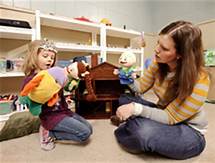 Arts-based initiatives can enhance the experience of being in the healthcare facility for patients, visitors, and professional caregivers.
Arts-based initiatives can enhance the experience of being in the healthcare facility for patients, visitors, and professional caregivers.
Programs and initiatives designed to enhance the patient experience are most frequently provided by specially trained professional artists. With increasing frequency, programs that employ professional artists and creative and expressive arts therapists are finding that active collaboration between the disciplines can provide patients with rich and meaningful services.
The rise of a mainstream movement referred to as patient-centered care (also person-centered care and family-centered care) calls for sophisticated medical care to be provided in a more personalized, humanized, and demystified manner.Community-based Arts and Wellbeing Programs
The arts have long provided natural frameworks in communities for social engagement, recreation, and cultivation of wellbeing. Activities like community and church choirs provide relaxation, creative engagement, and promote social cohesion. In these ways and others, the arts are inherently health-promoting and enhance overall well-being, or a sense of wholeness.
Community leaders and governments support the arts because they contribute to wellbeing and because they build cooperation and community vibrancy. There is increasing attention being placed on the roles of the arts in community development and placemaking. Arts activities such as festivals can engage diverse cross-sections of a community, including disadvantaged socioeconomic groups. Such engagement builds social capital and makes communities more liveable, while enhancing the wellbeing of individuals.
Collaborations among the arts, healthcare, and social services sectors of America’s communities are quickly expanding to develop powerful programs and services to support individuals’ health and wellbeing across their lifespans. Innovative arts programs and initiatives are being introduced for diverse community groups, such as through senior centers, long-term care communities, community centers serving people with chronic illnesses and profound disabilities, wellness programs, youth at risk populations, rehabilitation centers, disaster-response initiatives, cultural centers, libraries, prisons, and military/ veterans programs.Health and Wellbeing Outreach
Many hospital-based arts programs have developed outreach programs to extend their services to outpatients and to community members. Some of these programs represent efforts to provide a continuum of services that reach people at every stage of their healthcare journey, from diagnosis all the way through treatment, recovery, and survivorship. For example, dance and movement programs are being offered for women who have lingering effects, such as lymphedema from breast cancer treatment.
For example, Dance for PD (Parkinson’s disease) was developed in 2001 by the Mark Morris Dance Group in partnership with the Brooklyn Parkinson Group. The program quickly demonstrated that dance has tremendous value and has now been replicated in more than 100 communities in 16 countries. It has stimulated the development of an increasingly robust body of evidence that articulates the benefits of dance for people with PD.Community Development Planning
Arts in health outreach partnerships are becoming part of community planning and development and hold benefits for both healthcare organizations and arts organizations. Health partners sometimes struggle to find a point of intervention in a community. Arts organizations can help by providing gateways into community life across generations and cultural traditions, such as through attractive festivals and other events that people may be more likely to attend than other health-sponsored programming where participants are often self-selected.
Arts in community health and wellbeing promises to expand rapidly as America’s communities and healthcare system strive to meet the health needs of diverse population groups and an aging demographic in a comprehensive, productive way. In creative ageing the primary work in this area is retooling medical services, social services, and community services in ways to incorporate the arts, humanities, and design to build age-friendly communities.The Contribution of Art Forms
Music
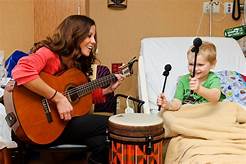 The professional artists most frequently employed by hospitals are musicians. From soothing piano music in the main hospital lobby to interactive songwriting at the patient bedside, musicians in healthcare provide distraction, meaningful engagement, encouragement of creative expression, and stress reduction that enhance the patient experience.Performing Arts
The professional artists most frequently employed by hospitals are musicians. From soothing piano music in the main hospital lobby to interactive songwriting at the patient bedside, musicians in healthcare provide distraction, meaningful engagement, encouragement of creative expression, and stress reduction that enhance the patient experience.Performing Arts
 Although music programs are most frequently offered, performing arts programming in healthcare can also feature dance, theatre, and/or creative writing – sometimes provided as part of artist residencies.
Although music programs are most frequently offered, performing arts programming in healthcare can also feature dance, theatre, and/or creative writing – sometimes provided as part of artist residencies.
Through local partnerships, high-level performing arts events can be offered in healthcare facilities. Arts organizations are learning that healthcare audiences are diverse and frequently have limited access to the arts due to geographic or socioeconomic circumstances, illness, or disability. Local arts organizations as well as university academic units and performing arts presenters are finding that partnerships with healthcare systems allow excellent opportunities to meet community engagement, outreach, and service learning goals.
The benefits of creatively and expressively engaging the body in environments that tend to de-humanize people are manifold. Dance and movement programs in healthcare facilities range from uplifting dance performances at the bed- side and in public areas, to physical activity sessions such as yoga and movement for staff and family members.
Theatre artists in healthcare facilities offer performances for groups of patients, visitors, and staff, and may also facilitate play- writing and narrative videography at the bedside. Drama is also widely used in medical education initiatives and in group sessions designed to provide the opportunity for patients to discuss healthcare issues. More than any other arts discipline, drama has been shown to be very effective in creating understanding. Through either observation or participation in a theatre experience, those present can explore difficult concepts and diverse emotional responses in a safe, structured context.Visual Arts
Interactive visual arts and crafts activities facilitated by trained artists in medical facilities or community healthcare settings provide numerous benefits. In medical/clinical set- tings, patients’ family members and medical staff can benefit from the restorative and relaxing experience that can result from art making.
Activities involving drawing, painting, and other visual media can help patients of all ages deal with pain, anxiety, and other challenges associated with illness and treatment.
The visual arts extend beyond the traditional media to include the full array of digital technology. Media artists are increasingly engaged in developing interactive digital arts for use in public lobbies and at the patient bedside, especially in pediatric healthcare settings.Creative Arts Therapists
Creative arts therapists (CATs) are highly trained health professionals who attain their qualifications through extensive course- work and supervised clinical training. They incorporate specific arts-based interventions and the creative processes in their practice to optimize patient health and wellness and ameliorate illness and disability. CATs enhance self-aware- ness; foster health, communication and expression; promote the integration of physical, emotional, cognitive, and social functioning; and facilitate behavioral and personal change.
Creative arts therapists work in a number of settings, including adult day treatment centers, community mental health centers, community residences and halfway houses, correctional and forensic facilities, disaster relief centers, drug and alcohol programs, early intervention programs, general hospitals, home health agencies, hospices, neonatal nurseries, nursing homes, outpatient clinics, psychiatric units and hospitals, rehabilitative facilities, senior centers, schools, and wellness centers.Art Therapy
Art Therapy is a regulated mental health profession that enriches the lives of individuals, families, and communities through active art-making, creative process, applied psychological theory, and human experience within a psychotherapeutic relationship. Art therapy is used to improve cognitive and sensory-motor functions, foster self-esteem and self-awareness, cultivate emotional resilience, promote insight, enhance social skills, reduce and resolve conflicts and distress, and advance societal and ecological change.
Art therapy engages the mind, body, and spirit in ways that are distinct from verbal articulation alone. Kinesthetic, sensory, perceptual, and symbolic opportunities invite alternative modes of receptive and expressive communication, which can circumvent the limitations of language. Visual and symbolic expression gives voice to experience and empowers individual, communal, and societal transformation.Dance/Movement Therapy
Dance/Movement Therapy (DMT) is defined by the American Dance Therapy Association (ADTA) as “the psychotherapeutic use of movement as a process which furthers the emotional, cognitive, physical, and social integration of the individual.” Based on the assumption that the body and mind are interrelated, the dance/movement therapist focuses on movement behavior as it emerges in the therapeutic relationship. Body movement simultaneously provides the means of assessment and the mode of intervention.Poetry Therapy
Poetry therapists introduce writing prompts and invite engagement with poems, stories, and memoirs, and other genres, in order to help clients achieve such therapeutic goals as enhanced self-esteem and sense of agency, increased awareness of personal habitual patterns, and strengthened capacity for resilience in the face of transitions, loss, or trauma. Through reading and writing activities, clients elaborate upon personally meaningful metaphors and capture, reframe, and derive fresh meaning from significant life stories.Drama Therapy
Drama Therapy is the intentional use of drama and/or theater processes to achieve therapeutic goals. Drama therapy is rooted in the fields of psychology, psychotherapy, occupational therapy, theatre, creative dramatics, psychodrama, and applied theatre. It is a dynamic method of working with client populations in a playful, embodied manner via the accessing power of metaphor. Qualified drama therapists pro- vide treatment through improvising scenes, role-playing, creative and projective play, or creating performances with the intent to raise awareness, change attitudes, expand life roles, and rehearse possible solutions to issues of concern.Psychodrama Therapy
Certified psychodramatists are professionals who are trained to utilize psychodramatic methodologies and sociometric interventions in both individual and group settings. Through psychodrama, issues and stories are explored using experiential action methods
Music Therapy
Music Therapy is the clinical and evidence-based use of music interventions to accomplish individualized goals within a therapeutic relationship by a credentialed professional who has completed an approved music therapy program.Caring for Caregivers
Caregivers – people who care for others – are found through- out healthcare facilities, in an array of community-based organizations, and in private homes. Caregivers can be professional (physicians, nurses, therapists, psychologists, social workers), paraprofessional (home health aides), and informal (unpaid family and friends of people requiring health care).
Constant care of people who are facing the physical, mental, and emotional challenges of coping with major illness or impending death often leads to significant stress, exhaustion, and depression.
For professional caregivers, burnout manifests as a deep physical, emotional, and spiritual exhaustion accompanied by feelings of reduced competence and a loss of compassion. Professional caregivers greatly benefit by using the arts to help lower compassion fatigue that they face in today’s intense healthcare facilities.
A healing built environment and innovative participatory arts programs can contribute greatly to addressing professional medical staff issues such as low productivity, high turnover, adverse patient events, job-related errors, poor service, and low patient satisfaction ratings.
Arts programs designed to care for caregivers can be created for professional caregivers, paraprofessional caregivers, and informal/family caregivers. Programs of this kind can most frequently be found for professional caregivers; similar programs for paraprofessional caregivers or family caregivers tend to be few and far between.Concluding Remarks
The rapid expansion of the field arts in community health offers a tremendous opportunity for growth of the arts, health, and well-being arena as a whole. Numerous grassroots arts initiatives that bridge cultures and generations together through traditional and folk arts are taking place in America’s communities. These arts in community health programs and events are taking place through formal institutions across the arts, medicine, education, and social service sectors, as well as within informal networks such as faith communities, neighborhood groups, and social networks.

![Call of the Dakini | A Memoir of a Life Lived [Extract]](https://regenesis.org.au/wp-content/uploads/2023/08/Catalogue-OF-Articles-by-Barbara-Lepani-July-2018-July-2023-.jpg)
Recent Comments